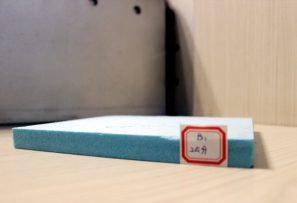
XPS挤塑板挤塑聚苯乙烯是我国普遍推广应用的新型建筑材料,这种利用废旧塑料变废为宝的新型环保材料,因其高强度、抗压性、优良的保温隔热性、质地轻、使用方便、优质的憎水、防潮性和环保性能、稳定性、防腐性好,成为建筑行业普遍推广的新型建材。广泛用于墙体和楼面保温。根据新版GB8624-20l2《建筑材料燃烧性能分级方法》的要求,分别对阻燃挤塑板和普通挤塑板进行燃烧性能检测。阻燃挤塑板的燃烧性能等级为B1(B)级,达到难燃水平,而普通挤塑板的燃烧性能等级为B3(F)级,属于易燃材料。通过对阻燃挤塑板和普通挤塑板的燃烧性能实验对比发现,经过阻燃挤处理能把挤塑板塑的燃烧等级从B3(易燃)提升到Bl(难燃)级别,阻燃效果比较明显,能够符合实际的应用和相关标准的要求。但是,实验室模拟的火灾环境跟现实发生火灾的所处的环境还是存在一定的差距。含有阻燃添加剂挤塑板可以阻止因小火而引起的意外起火,如一个烟头或切割火花可能不会对阻燃挤塑板引起意外火灾。但是在实际火灾环境中,由于受到持续火源的作用,阻燃挤塑板还是会放出大量的热量和有毒烟气,阻燃剂的作用会变得十分有限。而且,阻燃挤塑板在生产过程中也存在诸多问题:阻燃剂的分解温度低于挤塑板的加工温度势必造成阻燃剂大量分解,分解后产生的强酸不但腐蚀生产设备而且会使得塑料降解,降低挤塑板的分子量,力学性能直线下降,这也是目前阻燃挤塑板回收困难的重要因素;阻燃剂的分解也会造成自身阻燃效能的下降,而为了达到阻燃性不得不采用超常规添加阻燃剂的办法,造成浪费和环境的破坏;为了减少阻燃剂的分解损失,一些厂家采用了降低加工温度,超低温生产阻燃挤塑板的办法,这种方法虽然受到一定的效果,但是并没用从根本上解决问题,而且容易造成设备的磨损快、板子容重高、保温系数下降,也不利于挤塑板行业的健康发展。随着一些新材料、新技术和新工艺的不断发展,对挤塑板的阻燃性能的研究也在不断深入,原来被认为加工性能差、阻燃效能低的阻燃剂通过不断的改进各方面性能会不断得到提高,逐渐适应现代挤塑板阻燃的需求。

Xps extruded plastic sheet is a new type of building material which is widely used in China. This new type of environmental protection material uses waste plastic to turn waste into treasure, because of its excellent high strength, compression resistance, excellent heat insulation, light texture, easy to use, high-quality water-repellent, moisture-proof and environmental protection performance, stability, anti-corrosion good, become the construction industry to promote the new building materials. Widely used in wall and floor insulation. According to the requirements of the new edition GB8624-20l2"classification method of the burning properties of building materials" , the burning properties of fire-retardant extruded board and ordinary extruded board were tested respectively. The combustion performance of the fire-retardant extruded board is B 1B Class, which is difficult to burn, while that of the ordinary extruded board is B 3F Class, which belongs to the flammable material. Through the comparison of the combustion performance between the fire-retardant extruded board and the ordinary extruded board, it is found that the combustion grade of the extruded board can be raised from B3 to Bl through the fire-retardant extrusion treatment, and the fire-retardant effect is obvious, be Able to meet the actual application and the requirements of the relevant national standards. However, there is still a gap between the simulated fire environment and the real fire environment. Extruded plates containing flame retardant additives can prevent accidental fires caused by a small fire, such as a cigarette butt or cutting spark may not cause accidental fires on the extruded plates. However, in the actual fire environment, due to the effect of sustained fire source, the fire-retardant extruded board will still emit a lot of heat and toxic smoke, and the effect of fire-retardant agent will be very limited. Moreover, there are many problems in the production process of fire-retardant extruded board: The decomposition temperature of fire-retardant is lower than the processing temperature of extruded board, which will result in a large number of decomposition of fire-retardant, after decomposition, the strong acid not only corrodes the production equipment but also degrades the plastic, reduces the molecular weight of the extruded board and decreases the mechanical properties The decomposition of flame retardants can also cause the degradation of their flame retardancy, and in order to achieve flame retardancy, they have to use the method of supernormal addition of flame retardants, which results in waste and environmental damage, some manufacturers have adopted the method of lowering the processing temperature and producing fire-retardant extruded board at ultra-low temperature. Although this method has certain effect, it has not solved the problem fundamentally, and easy to cause equipment wear fast, board density high, thermal insulation Coefficient decline, is not conducive to the healthy development of extrusion board industry. With the continuous development of some new materials, new technologies and new processes, the research on the flame retardancy of extruded boards is also deepening, the flame retardant which was considered to have poor processability and low flame retardancy will be improved by improving its properties, and gradually meet the demand of modern extruded board flame retardancy.